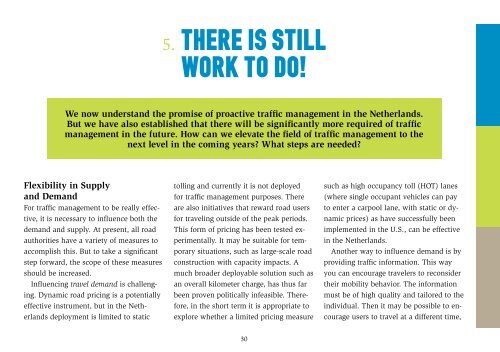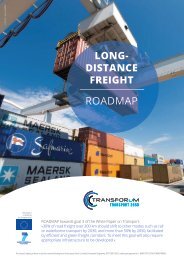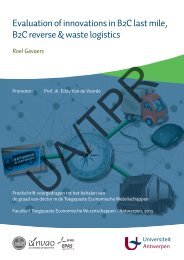the future of traffic management
the future of traffic management
the future of traffic management
Create successful ePaper yourself
Turn your PDF publications into a flip-book with our unique Google optimized e-Paper software.
Flexibility in Supply<br />
and Demand<br />
For <strong>traffic</strong> <strong>management</strong> to be really effective,<br />
it is necessary to influence both <strong>the</strong><br />
demand and supply. At present, all road<br />
authorities have a variety <strong>of</strong> measures to<br />
accomplish this. But to take a significant<br />
step forward, <strong>the</strong> scope <strong>of</strong> <strong>the</strong>se measures<br />
should be increased.<br />
Influencing travel demand is challenging.<br />
Dynamic road pricing is a potentially<br />
effective instrument, but in <strong>the</strong> Ne<strong>the</strong>rlands<br />
deployment is limited to static<br />
5. THERE IS STIll<br />
wORk TO dO!<br />
We now understand <strong>the</strong> promise <strong>of</strong> proactive <strong>traffic</strong> <strong>management</strong> in <strong>the</strong> Ne<strong>the</strong>rlands.<br />
But we have also established that <strong>the</strong>re will be significantly more required <strong>of</strong> <strong>traffic</strong><br />
<strong>management</strong> in <strong>the</strong> <strong>future</strong>. How can we elevate <strong>the</strong> field <strong>of</strong> <strong>traffic</strong> <strong>management</strong> to <strong>the</strong><br />
next level in <strong>the</strong> coming years? What steps are needed?<br />
tolling and currently it is not deployed<br />
for <strong>traffic</strong> <strong>management</strong> purposes. There<br />
are also initiatives that reward road users<br />
for traveling outside <strong>of</strong> <strong>the</strong> peak periods.<br />
This form <strong>of</strong> pricing has been tested experimentally.<br />
It may be suitable for temporary<br />
situations, such as large-scale road<br />
construction with capacity impacts. A<br />
much broader deployable solution such as<br />
an overall kilometer charge, has thus far<br />
been proven politically infeasible. Therefore,<br />
in <strong>the</strong> short term it is appropriate to<br />
explore whe<strong>the</strong>r a limited pricing measure<br />
30<br />
such as high occupancy toll (HOT) lanes<br />
(where single occupant vehicles can pay<br />
to enter a carpool lane, with static or dynamic<br />
prices) as have successfully been<br />
implemented in <strong>the</strong> U.S., can be effective<br />
in <strong>the</strong> Ne<strong>the</strong>rlands.<br />
Ano<strong>the</strong>r way to influence demand is by<br />
providing <strong>traffic</strong> information. This way<br />
you can encourage travelers to reconsider<br />
<strong>the</strong>ir mobility behavior. The information<br />
must be <strong>of</strong> high quality and tailored to <strong>the</strong><br />
individual. Then it may be possible to encourage<br />
users to travel at a different time,




